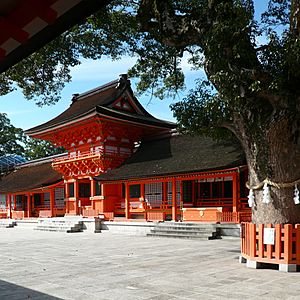Usa-jinjū facts for kids
Usa-jingū (宇佐神宮), also known as Usa Hachiman-gū (宇佐八幡宮), is a very important Shinto shrine in Japan. It is located in the city of Usa in Ōita Prefecture, which is on the island of Kyushu. Shinto shrines are special places of worship in Japan.
Contents
The Story of Usa-jingū
How Usa-jingū Started
Usa-jingū was built a very long time ago, between the years 708 and 714. This time period is known as the Wadō era in Japanese history. It was one of the earliest and most important shrines in Japan.
Shrine and Temple Together
In 779, a Buddhist temple called Miroku-ji was built right next to Usa-jingū. This was a big deal because it was one of the first times a Shinto shrine and a Buddhist temple were built together. This type of complex was called a jingū-ji, meaning "shrine-temple." The combined complex was known as Usa Hachimangu-ji (宇佐八幡宮寺). It stayed this way for many centuries, until 1868.
Usa's Place in History
Usa-jingū is mentioned in ancient Japanese records. It first appears in the history books during the time of Empress Shōtoku. She was a powerful ruler in Japan's past.
A Chief Shrine
Usa-jingū was chosen as the main Shinto shrine for an old area called Buzen Province. Today, it is still considered one of the most important shrines in both Oita and Fukuoka Prefectures. From 1871 to 1946, the Japanese government officially supported Usa-jingū as a top-ranked shrine.
Many Branch Shrines
Usa-jingū is special because it is the main shrine for over 40,000 other Hachiman shrines. These are called "branch shrines." In Shinto belief, these many branch shrines help spread the influence of the kami (gods or spirits) from Usa-jingū all across Japan. It's like Usa-jingū is the parent shrine, and all the others are its children.


